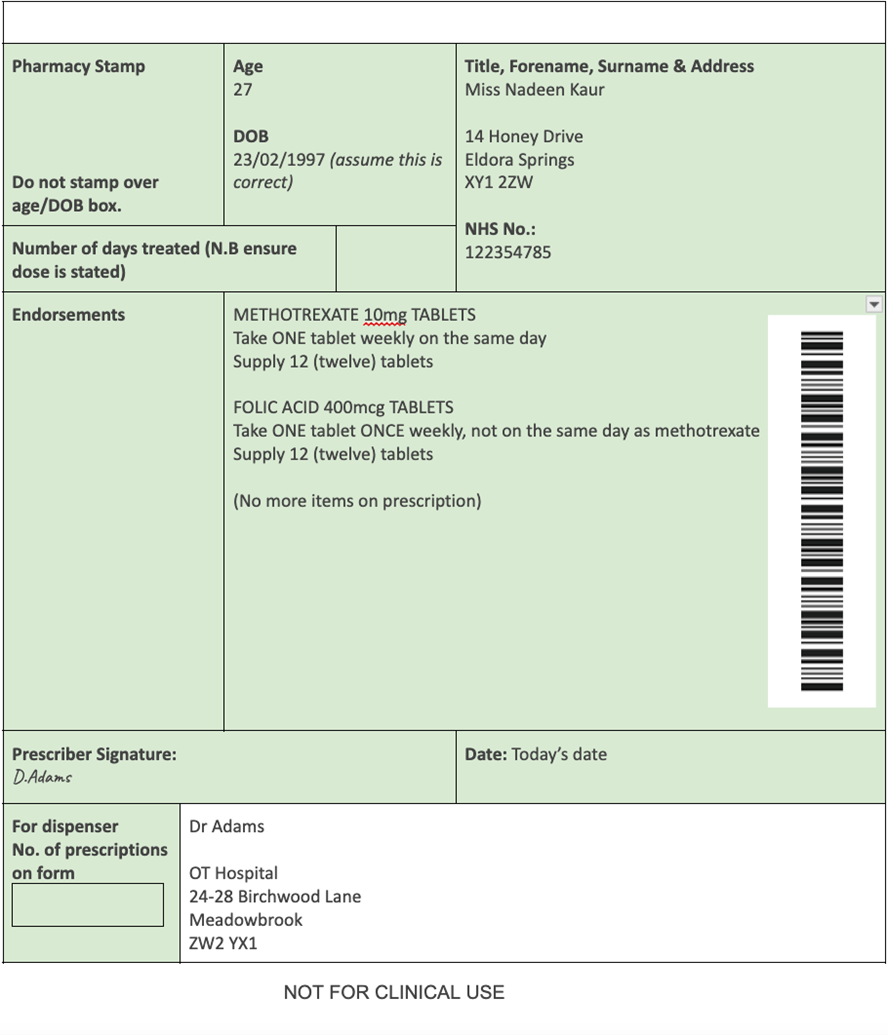 Add to Favourites
Add to Favourites


...
...
×
Scenario Tabs
In this scenario, a patient comes to the hospital pharmacy to collect a prescription. The pharmacist should check the prescription and contact the prescriber if any errors are found to rectify the mistakes.
Please ensure that this scenario and mark scheme aligns with the most up-to-date guidelines from the UK NICE and the BNF when using it for your OSCE assessment.
You will need a student pharmacist and an actor for this OSCE station.
Crohn's disease
You are working in a hospital outpatient pharmacy. A 27-year-old patient comes to collect their discharge prescription. You need to check the prescription and respond appropriately.
You do not contact the prescriber for this station. Discuss your prescription checking aloud. Do not worry about using medical jargon.
To do
You must perform a legal, accurate and clinical check on this prescription using the latest up-to-date guidance.
If necessary, state any changes you wish to make to the patient actor.
You have 8 minutes.
You have access to the BNF.
The prescription:

You are Nadeen Kaur (Nuh-deen, Kar)
Opening statement: “Hi, I’ve just been discharged, would I be able to collect my new prescriptions today?”
Patient Information:
Provide this information when prompted.
If the pharmacist mentions waiting for a new prescription because of a low dose:
Accept the student's response
Any criteria marked in red must be met to pass this station.
 Red Flags missed: 0
Failed missed: 3
Red Flags missed: 0
Failed missed: 3
Referral Criteria for Methotrexate
Refer to Accident and Emergency (A&E) if:
· Lips or tongue become swollen, difficulty breathing or struggling to swallow: Signs of allergic reaction.
Refer for an Urgent GP Appointment if:
· Oral ulcers present: Sign of bone marrow suppression, increasing likelihood of infection.
· sore throat: Sign of bone marrow suppression, increasing likelihood of infection.
· Unexplained rash: This could indicate a severe allergic reaction or drug-induced skin conditions, such as Stevens-Johnson syndrome or toxic epidermal necrolysis.
· abnormal bruising: could be a sign of thrombocytopenia (a low platelet count) or bone marrow suppression.
· Persistent diarrhoea: a sign of gastrointestinal toxicity, which could lead to severe dehydration and electrolyte imbalances.
· Yellowing of skin or eyes, abdominal pain: May indicate liver toxicity.
· Swollen hands or feet, and difficulty urinating: May indicate renal impairment.
· Bleeding in gums, urine, vomit, bruising: Possible indicator for agranulocytosis.
· New or increasing dyspnoea or dry cough: may indicate methotrexate-induced pneumonitis, a potentially serious lung condition.
· HSC Public Health Agency. (n.d.). Methotrexate Oral (Adult) Shared Care Guidelines. [PDF] Available at: https://ipnsm.hscni.net/download/19/shared-care-guidelines/1432/methotrexate-oral-adult.pdf [Accessed 20 Aug. 2024].
· National Health Service (NHS). (2023). Methotrexate. [online] Available at: https://www.nhs.uk/medicines/methotrexate [Accessed 20 Aug. 2024].
· National Institute for Health and Care Excellence (NICE). (2023). Methotrexate: BNF. [online] Available at: https://bnf.nice.org.uk/drugs/methotrexate/ [Accessed 20 Aug. 2024].
· Electronic Medicines Compendium (EMC). (2023). Methotrexate 2.5mg Tablets - Summary of Product Characteristics (SmPC). [online] Available at: https://www.medicines.org.uk/emc/product/5443/smpc#gref [Accessed 20 Aug. 2024].
This website uses cookies to ensure you get the best experience
Learn more
 Scenarios
Scenarios
 Info Capsules
Info Capsules
 Videos
Videos
 Articles
Articles